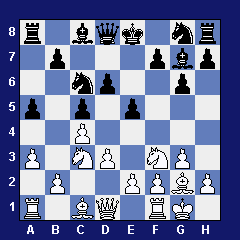|
 Lakdawala,C
(2437) - Yermolinsky,A (2575) [A37] Lakdawala,C
(2437) - Yermolinsky,A (2575) [A37]
38th American Open Los Angeles USA (7), 01.12.2002
Yermo is a tough opponent for me (or anyone for
that matter). Problem is, Yermo and I have exactly the same
style, except that he outrates me by 100 points. The result when
this sort of thing happens is that your minds are thinking along
the same lines, except that his processor is faster and better.
If you are the lower rated player I have found that
its much more in your favor to play and opponent with a totally
opposite style. 1.Nf3 g6 2.c4 Bg7 3.Nc3 c5 4.g3 Nc6 5.Bg2 e5
6.0-0 d6 7.a3 a5 8.d3?!
 The
normal move here is 8.Ne1 with the idea to transfer to e3, via the
c2 square. On e3 white has a lock on the important d5 square. Trouble
was, paranoia set in: "What if he plays ...h5!? and mates me on
the h-file? A lot of good control of d5 would do me then," I thought. The
normal move here is 8.Ne1 with the idea to transfer to e3, via the
c2 square. On e3 white has a lock on the important d5 square. Trouble
was, paranoia set in: "What if he plays ...h5!? and mates me on
the h-file? A lot of good control of d5 would do me then," I thought.
Looking back it looks like an irrational decision.
i.e. 8.Ne1 h5?! 9.Nc2 ( 9.Nf3!?) 9...h4 10.Ne3 Be6
11.Ned5 and Black can't play either ...Qd7 or ...Qc8 due to the
fork on the b6 square. White should be able to generate punishing
counterplay then with a b2-b4 later.
8...Nge7 9.Ne1 Be6 Threatening to grab the
initiative with 10...d5. 10.Nd5 Had I played 8.Ne1! I could
then have played here 10.Ne3! 10...0-0 11.Nc2 Rb8 12.Bg5 f6 13.Bd2
b5 14.b3 h6 15.Rb1 f5
Here it comes. Now the principle is that a wing
attack is best met by a counter in the center, so 16.f4 is an option.
Another idea is to chicken out and head for a very drawish position
with mass exchanges. I should have played this or gone for 16.f4.
Now Yermo's pieces come to life.
|